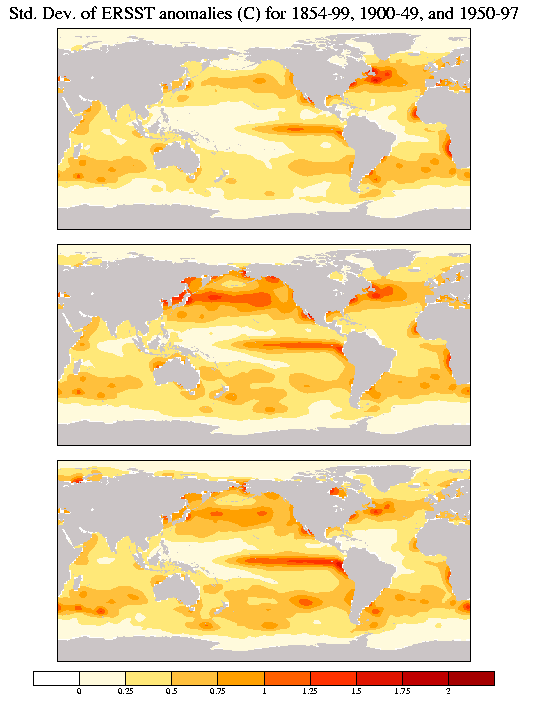Tom Smith, Dick Reynolds, and Chungying Liu produce the
extended reconstructed sea surface temperature data set (ERSST), and
NCDC
has a nice WWW page documenting this data set.
From the documentation
file (14 November 2008)
:
We have made improvements to NOAA's Historical Merged Land-Ocean
Surface Temperature Analysis. This version is version 3 and is
documented in Smith, T.M., R. W. Reynolds, T. C. Peterson, and
J. Lawrimore, 2008: Improvements to NOAA's historical merged
land-ocean surface temperature analysis (1880-2006). J. Climate, 21,
2283-2296. A reprint is available at:
http://www.ncdc.noaa.gov/oa/climate/research/sst/papers/SEA.temps08.pdf.
The analysis is derived from two independent analyses, a sea surface
temperature (SST) analysis (the Extended Reconstruction of SST version
3) and a land surface temperature analysis using the global historical
climatology network temperature database.
As explained in the preprint, there are 3 major changes of version 3
over version 2. First, we improved the tuning procedures using
simulated data. The result of the change is that data have a stronger
influence on the analysis prior to 1930. This can be seen in figure 6
of the reprint. In this figure the global surface temperature in shown
for the merged version 2 and 3 as well as for the UK HadCRUTv
analysis. The second change is that we now process the sea ice
directly using our own sea-ice bias correction in ERSST. This change
allows the analysis to be made in a more timely fashion. Analyses for
the previous month are now available on the third day of the current
month. The third change was the addition of satellite data to the SST
analysis beginning in 1985.
In the ERSST version 3 on this web page [version 3b] we have removed satellite data
from ERSST and the merged product. The addition of satellite data
caused problems for many of our users. Although, the satellite data
were corrected with respect to the in situ data as described in
reprint, there was a residual cold bias that remained as shown in
Figure 4 there. The bias was strongest in the middle and high latitude
Southern Hemisphere where in situ data are sparse. The residual bias
led to a modest decrease in the global warming trend and modified
global annual temperature rankings.

PostScript | JPEG
The standard deviation of SST anomalies for 1854-99,
1900-49, and 1950-97 are qualitatively similar. This analysis is
derived from version 1 of the data.
Data:
netCDF format:
At the JISAO: /home/disk/margaret/data/sst_ncdc/ersst
The NOAA Earth System Research Laboratory provides the data in
netCDF, updated monthly. Please acknowledge NOAA
ESRL in your publications if you use data that they serve.
WWW
page | sea
surface temperature (sst.mnmean.nc) | normalized
errror variance (err.mnmean.nc) | 1971-2000 climatology
landmask (1 land, 0 sea) from the JISAO
ASCII format:
1854 -
last month from NOAA NCDC
Reference:
Smith, T.M., R.W. Reynolds, T.C. Peterson, and J. Lawrimore
2008: Improvements to NOAA's Historical Merged Land-Ocean Surface
Temperature Analysis (1880-2006). J. Clim., 21, 2283-2296.
